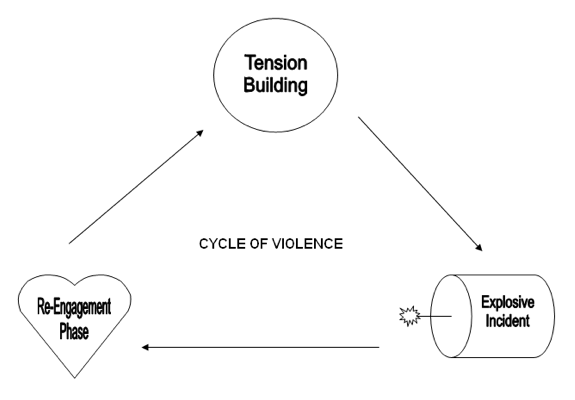About Domestic Violence
[line]
Fact:
Domestic violence crosses all age, ethnic, socioeconomic, religious, and educational boundaries. There are doctors, ministers, psychologists, police, attorneys, judges, and other professionals who beat their partners. Battering also occurs in same gender relationships.
Domestic violence is virtually impossible to measure with absolute precision due to numerous complications including the societal stigma that inhibits victims from disclosing their abuse and the varying definitions of abuse used from study to study. Estimates range from 960,000 incidents of violence against a current or former spouse, boyfriend, or girlfriend per year to 3.9 million women who are physically abused each year. Thirty percent of Americans say they know a woman who has been physically abused by her husband or boyfriend in the past year.
An abusive relationship can be defined as one in which a partner uses a pattern of assaultive and coercive behaviors to maintain power and control over the other partner. This includes couples who are married or unmarried, gay or straight. Types of abuse can include physical, emotional, social, economic, and sexual.
Cycle of Violence
Phase 1 – Tension Building
A victim often senses that the abuser is becoming edgy and more prone to lash out at trivial frustrations. The victim may learn to anticipate abuse and try to control it by being more nurturing and compliant or by simply staying out of the abuser’s way. This phase is marked by many “minor” abusive actions that gradually increase in severity. Quite often the event which will trigger the battering phase is initiated by the abuser who may make a demand which the victim cannot meet, and responds to her/his refusal or inability to act with violent behavior.
Abuse victims often accept the building rage in a partner as being legitimately directed towards her/him. The victim internalizes the responsibility of keeping the situation from exploding. If she/he does their job well, the abusive partner will become or remain calm; if she/he fails, the victim believes it is their own fault. A victim who has been battered over time knows that she/he can do nothing to stop the tension from building, but often denies this knowledge to help cope with the partner’s behavior.
Phase 2 – Acute Battering Incident (Explosive Incident)
When the abuser finally becomes violent, the severity of the assault and where it occurs is impossible to predict. This phase is characterized by explosive and unpredictable rage. This may involve pushing, shoving, shaking, or hair pulling. It may involve hitting with an open hand or a closed fist. It may involve intense yelling and name calling. It may be over in a moment or last for hours. If the assault has been physical, there may be visible injuries, but often an experienced batterer will leave no marks. The attack rarely takes a single consistent form. The attack is followed by shock, denial and disbelief. Most victims consider themselves lucky that it was not worse, no matter how bad their injuries are. They often deny the seriousness of their injuries and refuse to seek medical help if it is needed. The abuser denies violence, and justifes the behavior by saying the original intent was to simply teach the victim a lesson, and she/he “just lost control.”
Phase 3 – Aftermath: Loving Respite (Re-engagement Phase)
Victims may enter the criminal justice system after an acute battering episode, but after the assault comes a period of calm, loving, contrite behavior. Both the abuser and the victim feel guilty about the event and resolve never to “let” it happen again. The batterer will very typically treat the victim with apparent respect, love and affection. This is a great relief for the victim and is precisely what was desired from the relationship all along.
The abuser apologizes for what happened and asks for forgiveness. The abuser may even believe she/he will not do it again. The abuser promises to control her/himself and will never again hurt the partner she/he loves. An abuser may even agree to go to therapy (but will usually drop out when the relationship resumes the tension building phase). The abuser tells the victim that she/he would fall apart without them, and the victim wants to believe she/he will no longer have to suffer abuse. An abuser’s reasonableness and loving behavior during this period support the victim’s wish that the partner can really change. The victim takes responsibility for their abuser’s well-being and for the abuse. If the victim has filed charges against the “reformed” partner, she/he may consider dropping them. As long as the abusive partner continues to behave affectionately, the victim becomes increasingly reluctant to jeopardize such good behavior by proceeding with a prosecution or anything considered a disturbance to the relationship.

